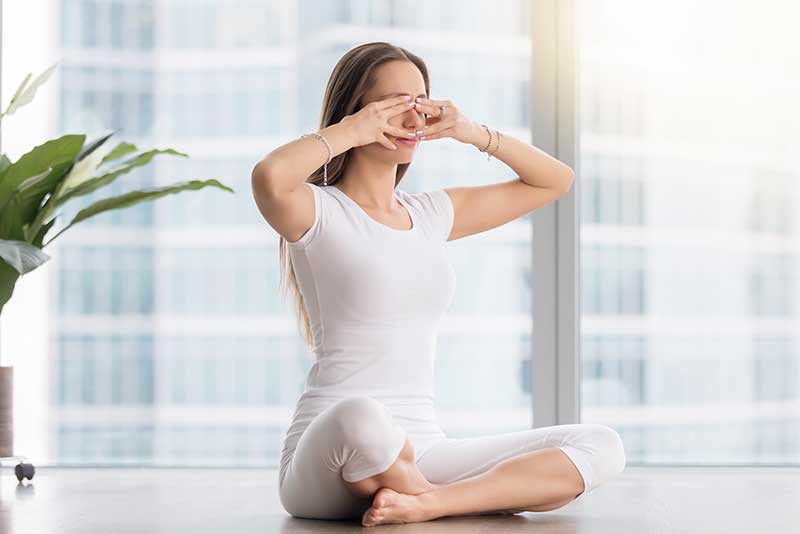We all have been there; laying in bed and staring at the ceiling, wondering when we will fall asleep. You might be exhausted and want to sleep so that you can rest, but your brain is not cooperating with you. Well, you are not alone. Today’s a busy and fast-paced lifestyle filled with financial constraints, long working hours, and personal stress can exhaust you and make it very hard to calm down, unwind and get a restful sleep. It can be frustrating, but when it is difficult to fall asleep then probably deep breathing exercises can help you.
Let’s take a look at these eight deep breathing exercises for better sleep.
1. 4-7-8 Breathing
- First, you need to put the tip of your tongue on the roof of your mouth right behind the top of your front teeth. Your tongue will stay there until the whole process is complete.
- Then part your lips and empty your lungs by exhaling through your mouth by making a whooshing sound.
- Now close your lips and inhale through your nose for four seconds.
- Hold your breath for seven seconds.
- Exhale forcefully through your mouth for eight seconds while making a whoosh sound. You can repeat this cycle at least four to five times.
- 4-7-8 breathing exercise is based on yoga breathing exercises which help people to relax and unwind as it replenishes the oxygen in the body and puts you to sleep.
Benefits:
- Replenishes oxygen in the body
- Promotes relaxation and unwinding
- Helps induce sleep
Precautions:
- Avoid if you have respiratory issues
- Start slowly to prevent dizziness
2. Bhramanayamari pranayama

- Sit on your bed with your back straight. Now close your eyes and cover your ears with your thumb.
- Place your index fingers over your eyebrows and cover your eyes with the rest of the fingers.
- Now gently put a little pressure on the sides of your nose with your ring finger and try to focus on your brow area.
- Close your mouth and take a deep breath in from your nose and as you exhale through your nose make an ‘om’ sound. You can repeat this process at least four to five times.
- Bhramari pranayama is a yogic breathing exercise (pranayama) that is proven to reduce heart and breathing rate (study 1). It has a very calming effect and prepares your body for deep sleep.
Benefits:
- Reduces heart and breathing rates
- Calms the mind
- Prepares the body for deep sleep
Precautions:
- Avoid practicing if you have ear infections
- Do not press too hard on your nose
3. Diaphragmatic breathing

- Lie down on your back and put a pillow underneath your knees or you can also sit on the chair.
- Place your left hand on the chest and your right hand on the belly. Now take a deep inhale through your nose and let your stomach rise as it fills with air.
- Exhale slowly through your pursed lips (the way you blow the whistle). Repeat this process for few times.
- Diaphragmatic breathing strengthens your diaphragm and other lungs muscles. It also helps to calm you so that you can get a good night’s sleep.
Benefits:
- Strengthens diaphragm and lung muscles
- Calms the mind
- Promotes a good night’s sleep
Precautions:
- Avoid if you have severe respiratory conditions
- Start slowly to avoid lightheadedness
4. Three-part breathing exercise

- To practice this breathing technique, all you have to do is inhale deeply.
- While you are exhaling fully, focus deeply on your whole body and how it feels while you are breathing.
- After repeating this a few times, you have to slow your exhale until it becomes twice long as your inhale.
- This breathing exercise is a favorite for most people as it is super easy to practice.
Benefits:
- Enhances body awareness
- Promotes relaxation
- Easy to practice
Precautions:
- Avoid if you feel dizzy
- Start slowly and increase duration gradually
5. Alternate nostril breathing

- It is also called nadi shodhan pranayama.
- Sit on your bed in a cross-legged position keeping your back straight.
- Put your right thumb on your right nostril and inhale through the left nostril.
- Hold for a few seconds and then close your left nostril from your ring finger and exhale through the right nostril. Now inhale through your right nostril keeping your left nostril closed.
- Hold for a few seconds and then close your right nostril from your right thumb and exhale from the left nostril. Repeat this cycle of slow breathing for a few more breaths.
- Studies (study 3) have shown that practicing this deep breathing benefits people in reducing stress and anxiety.
Benefits:
- Reduces stress and anxiety
- Balances the nervous system
- Promotes mental clarity
Precautions:
- Avoid if you have nasal congestion or infection
- Practice gently to avoid nasal irritation
6. Buteyko Breathing

- Sit on your bed in a cross-legged position and close your mouth. Try to breathe normally for 30 seconds through your nose.
- Now try to breathe more intentionally through your nose. Then gently close your nose with your thumb and forefinger and also keep your mouth closed as well until you feel that you need to take a breath.
- Now again, keeping your mouth closed, take a deep inhale and exhale through your nose.
- If you are feeling that you are hyperventilating, then Buteyko breathing can bring you back to your normal breathing and make you relax.
Benefits:
- Normalizes breathing patterns
- Reduces hyperventilation
- Promotes relaxation
Precautions:
- Avoid if you have severe respiratory issues
- Start slowly to avoid discomfort
7. Box Breathing
- Sit on your bed, keeping your back straight, and take a deep inhale till the count of four. Make sure to fill your lungs with more air as you increase your count.
- Now you have to hold your breath till the count of four. And then you have to exhale through your mouth till the count of four. Focus on emptying your lungs as much as you can while exhaling. Repeat this process for few times.
- Box breathing is a very common breathing technique practiced during meditation and a powerful breathing exercise for anxiety. One can use this technique to make yourself calm before sleeping.
Benefits:
- Reduces anxiety
- Enhances focus and concentration
- Promotes calmness
Precautions:
- Avoid if you feel lightheaded
- Start slowly and increase duration gradually
8. Papworth Method
- Sit on your bed, keeping your back straight. Now you have to take a deep inhale and exhale while counting to four. You can do it through your nose or mouth; however, you have to exhale through your nose.
- Focus on your belly as it rises and falls during inhale and exhale. Listen to the sound of your breath coming from your stomach.
- This relaxing breathing technique allows you to breathe more naturally. It also helps in reducing yawning and sighing.
So next time you have trouble falling asleep practice these eight breathing techniques for sleep.
Benefits:
- Promotes natural breathing
- Reduces yawning and sighing
- Calms the mind
Precautions:
- Avoid if you have severe respiratory conditions
- Start slowly to prevent discomfort

Mr. Vijay Kumar Pandey is an eminent Yoga teacher with 15 years of experience. He excelled himself in Iyengar Yoga under the guidance of revered master BKS Iyengar Read More



